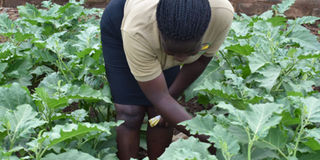Crop rotation as soil management tool

The most important role of crop rotation is to prevent the build-up of pest and disease problems in the soil to which a crop is susceptible.
If the same crop or a similar type belonging to the same family is grown in the same field, it will suffer from the accumulated pests and diseases from the previous crop and may not grow well.
One way to avoid this challenge is fallowing, or planting tolerant or resistant crop to the particular pest or disease.
Better still, a crop from a different family can be planted. But experts advise that there is more to rotation than switching crops.
According to Henry Ssali, a soil fertility management researcher at National Agricultural Research Laboratories (NARL-Kawanda), an integrated approach that involves use of organic and inorganic fertilisers, biological nitrogen fixation, rotations, agroforestry, as well as proper soil and water practices, are important in reducing soil degradation.
In a study published in 2000 in the Uganda Journal of Agricultural Sciences, Ssali explains that in the early stages, Uganda’s soils were considered fertile and little was done to improve productivity. But after studying the causes of infertile patches in the country like ‘lunyu’ soils in central Uganda and sterile acidic swamps, a systematic approach was adopted.
“However, it was soon realised that crop yields declined under continuous cultivation leading to the recommended use of organic materials, crop rotations, and grass rests, among others to improve and sustain soil productivity,” says Ssali.
Considerations
James Mugerwa Sebudde, an extension worker in Buvuma District, says certain principles need to be followed for effective crop rotation. Mugerwa says carefully selected rotations can greatly assist control of plant diseases and nematodes.
“Sometimes a one-year break is sufficient for disease control, while for other diseases a number of years of growing a non-host crop is needed to sufficiently reduce inoculation,” he says.
Some diseases enter the field on contaminated seed, while others such as wheat leaf rust and mildew, are airborne. “This shows that other strategies, aside from rotations, are needed to deal with such diseases,” he says.
During crop rotation, consideration should be made in what condition a particular crop will leave the soil for the succeeding crop.
According to Mugerwa, diseases prevent the same problems. “By principle, many farmers follow leaf crops after root crops. But one can end up achieving nothing,” he says.
In case of a root crop such as carrots and spinach (a leaf crop), both are vulnerable to root knot eelworm.
“So rotating between them will not get rid of the nematodes,” he says.
He adds that a farm infected with beet cyst eelworm which stunts growth, causing wilting and yellowing and in some instances death of crops, cannot be followed with crops from the brassica family such as cabbage, beetroot, sugar beets, broccoli, and radish because the build-up of the pest will continue.
For the same reason, it is a mistake to follow tomatoes with a crop susceptible to the eelworm pathogens, unless one uses hybrids.
Keep records
According to Mugerwa, keeping a record of farm history is a great help in remembering which crop has in the past been grown in a particular plot within the field or farm.
This is useful especially if the records also show past incidents of plant pests or diseases in each plot in the farm. He advises one to divide the farm into small units to facilitate ad hoc placement of crops onto fields each year.
By this means, cropping history of every part of each field is easy to maintain as problem plots can be easily identified.
Guiding principles
In the rotation of crops, Mugerwa says that the general principle is for leguminous crops such as pulses, beans, peas, groundnut and green gram to be grown after cereal crops like wheat, maize and millet.
“When the cereal crops such as rice, wheat and maize are grown in the soil, it uses up a lot of nitrogenous salts from the soil. If another cereal crop is grown in the same soil, it becomes nitrogen deficient,” he says.
So by rotation, a leguminous crop has the ability to fix atmospheric nitrogen to form nitrogen compounds through the help of certain bacteria present in their root nodules.
These nitrogen compounds go into the soil and make it more fertile.
Mugerwa adds that exhaustive crops (crops which feed heavily on the soil and deplete soil nutrients) such as potato, sugarcane, sorghum, tobacco and sunflower, should be alternated with less exhaustive crops like oilseeds and pulses to restore the fertility of the soil.
“The continuous cultivation of exhaustive crops in the same land leads to gradual reduction of soil fertility or nutrient status of the soil. Therefore, restorative crops whose root nodules in the roots fix atmospheric nitrogen into in the soil are ideal alternates,” he says.
He adds that legumes such as alfalfa, peas, beans, lentils, soy and peanuts shed their leaves while reaching maturity which adds more nutrients to soil.
In case of the tap root crops like beetroot and carrot, they should be grown alternately with fibrous root crops for uniform utilisation of soil nutrients.
Agronomy
On sloppy lands, Mugerwa says, alternate cropping of erosion promoting and erosion resisting crops should be adopted.
He says that rotations with alfalfa and other legumes reduce fertiliser needs because these plants replace some of the nitrogen removed by maize and other grain crops.




